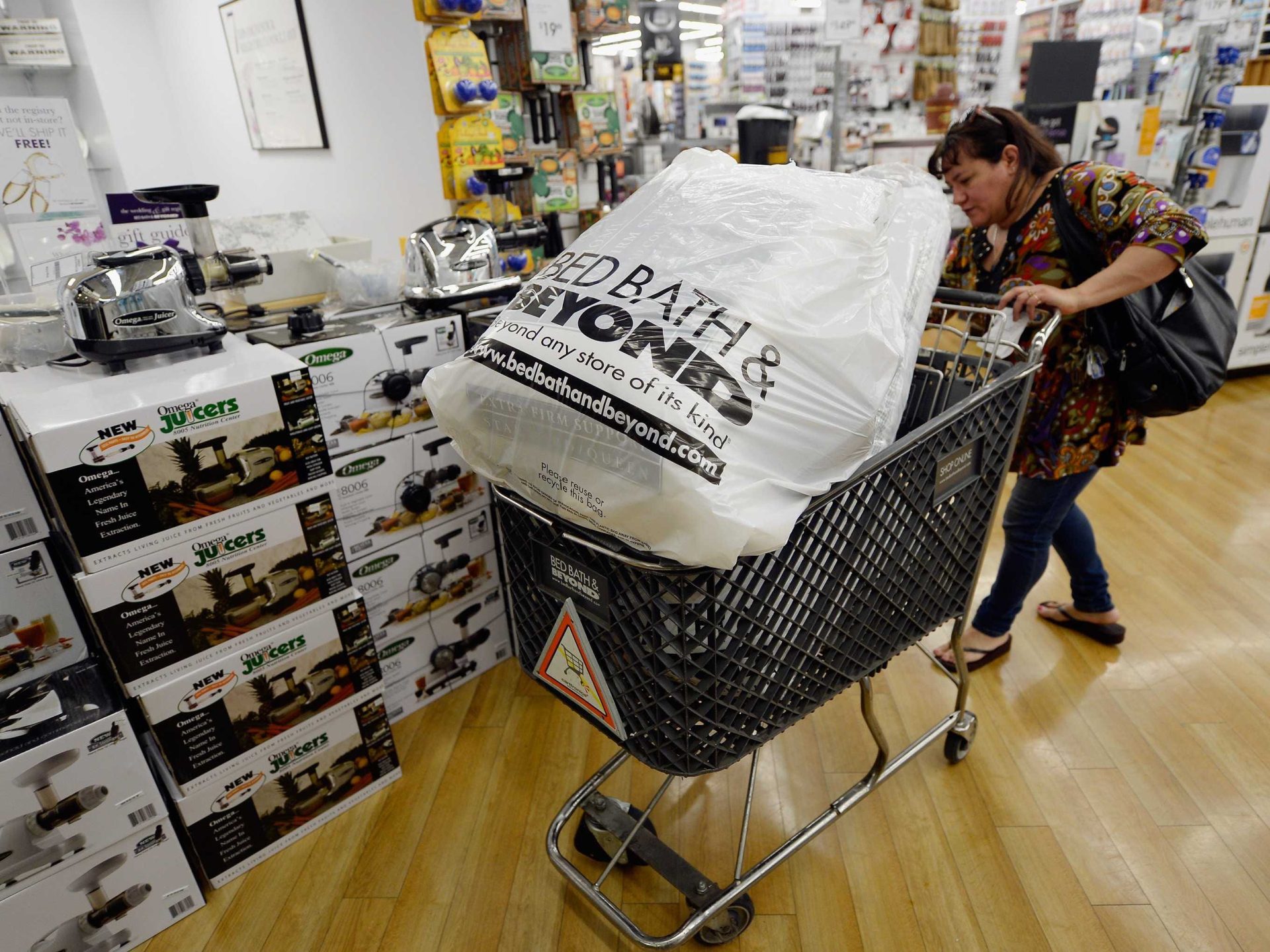Since its founding in 1971, Bed Bath & Beyond has been a go-to destination for home goods.
However, the retailer has recently struggled, saying in January 2023 it may file for bankruptcy.
We took a look at the rise and decline of the iconic big-box retailer.
The company said in an SEC filing Thursday that it has “substantial doubt” it can continue operating and is considering filing for bankruptcy.
The situation worsened when activist investor and GameStop Chairman Ryan Cohen sold his 9.8% stake in the company earlier this month. Now, analysts are saying the company may be in its “end days.”
Bed Bath & Beyond was once a leading home goods retailer, appealing to shoppers across the nation with its strategy of abundance. The beloved store, which lined strip malls nationwide, became known for its huge assortment of products spanning every color and style.
Over the years, it became a go-to for just about anything for the home and — true to its name — beyond.
We took a closer look at Bed Bath & Beyond’s rise from a small linen store in New Jersey to a major national retail chain now on the brink of collapse.
Bed Bath & Beyond was founded in 1971 in New Jersey by Warren Eisenberg and Leonard Feinstein.
Shoshy Ciment/Business Insider
The duo had formerly worked in management at Arlans, a local discount chain, and saw opportunity for growth in the bed and bath categories.
“We had witnessed the department store shakeout, and knew that specialty stores were going to be the next wave of retailing,” Feinstein told the trade publication Chain Store Executive in 1993.
It was originally called Bed ‘n Bath, to reflect its specialty linens and bath products. The company would later rebrand to Bed Bath & Beyond in 1987.An employee pushes a cart on his shift.
Mark Peterson/Corbis via Getty Images
By 1985, Bed Bath & Beyond had expanded to 17 locations, primarily in the greater New York area and California.
Justin Sullivan/Getty Images
The 1980s also marked an era of increased competition for Bed Bath & Beyond, thanks to the rise of stores like Linens ‘n Things.
David McNew/Getty Images
In response, the company launched in 1985 its first superstore concept, a 20,000-square-foot store that would become the model for the modern Bed Bath & Beyond store.
Justin Sullivan/Getty Images
The company has been widely credited as being at the forefront of the superstore movement in America.
This new massive store featured a wide array of brands and products in nearly every color and style, setting it apart from department stores at the time that tended to stock a limited assortment of specialty collections.
Business Insider/Jessica Tyler
Source: Funding Universe
This strategy is known by analysts as the “category killer,” a method also employed by retailers like Toys R Us, Best Buy, and Costco.
Getty Images
This method is intended to bring more shoppers into stores by selling a little bit of everything across all categories and consumer demographics.
Over the next few years, Bed Bath & Beyond opened more superstores in New Jersey, California, Virginia, Illinois, Maryland, and Florida.
Michael Brochstein/SOPA Images/LightRocket via Getty Images
Source: Funding Universe
Its new store model — which smartly grouped product categories and strategically placed impulse buys near the register — was particularly conducive to strong sales. By 1991, sales reached $134 million.
Shoshy Ciment/Business Insider
Source: Funding Universe
Bed Bath & Beyond filed for an IPO in June 1992.
Kevork Djansezian/Getty Images
As the company continued to grow, it added popular categories like electric appliances.
Shoshy Ciment/Business Insider
In 1999, it reached $1 billion in sales.
Getty/Kevork Djansezian
Source: Funding Universe
By the start of the millennium, Bed Bath & Beyond had 311 stores across 43 states.
Shoshy Ciment/Business Insider
Source: Funding Universe
In 2002, Bed Bath & Beyond acquired the health and beauty retailer Harmons, followed by the holiday chain Christmas Tree Shops in 2003.
Artur Widak/NurPhoto via Getty Images
Over the next 10 years, the company continued to focus on acquisitions, including purchasing Buy Buy Baby in 2007.
Bed Bath & Beyond additionally purchased both Linen Holdings and Cost Plus World Market in 2012.A shopper at World Market.
Lisa Lake/Getty Images
By then, Bed Bath & Beyond began to hold a prominent place in popular culture, appearing in shows like “Broad City.”
Comedy Central
During this period, big-box stores like Bed Bath & Beyond began to show signs of struggle, as consumers turned to e-commerce and other cross-category competitors like Walmart and Target.
Shoshy Ciment/Business Insider
Source: Racked
Suddenly, stores like Linens ‘n Things were going out of business.
Getty
In May 2019, CEO Steven Temares was ousted by a group of activist investors who called for his resignation in a brutal 168-slide presentation. Several board members also stepped down at the behest of investors.
Business Insider/Jessica Tyler
In the presentation, the investors called company leaders at fault for failing to adapt to the modern retail landscape and causing sales to tank.
In November 2019, former Target CMO Mark Tritton took over for interim CEO Mary Winston as the company’s new leader.
Gary Gershoff/Getty Images
Source: Business Insider
While some experts at the time anticipated that the appointment of Tritton — who formerly served as chief merchandising officer at Target — would bring promise, it wasn’t expected to be an easy turnaround.A messy display at a Bed Bath & Beyond store in New York City.
Shoshy Ciment/Business Insider
Source: Forbes
Under Tritton, the company attempted to adopt a less “cluttered” and more organized shopping experience, including implementing “the biggest change in its product assortment in a generation.”
Mary Meisenzahl/Insider
Source: Insider, WSJ
The revamp involved reducing its product selection and launching its own private-label brand.
Mary Meisenzahl/Insider
Despite a boom in sales at the beginning of the pandemic, thanks to an increased interest in home goods, Bed Bath & Beyond’s newly limited product selection exacerbated supply-chain issues, leading to empty shelves and frustrated shoppers.
Mary Meisenzahl/Insider
Source: Insider
Sales continued to decline, worsening with record-high inflation and decreased customer demand in recent months, according to Tritton.
Mary Meisenzahl/Insider
“Our business has been impacted by extraordinary macroeconomic factors, such as the derailing of the global supply chain, continued disruptions from the Omicron variant, unprecedented inflation, rising interest rates, and a turbulent geopolitical landscape which have also weighed on consumer confidence,” Tritton told investors in April.
In June 2022, the company announced it would replace Tritton as CEO, as well as swap out several top executives, marking yet another leadership shakeup for Bed Bath & Beyond.Mark Tritton
John Lamparski/Getty Images
The company became the subject of a meme-stock rally in August 2022, thanks largely to activist investor Ryan Cohen.Bed Bath & Beyond wanted to prevent overpacked shelves
REUTERS/Emily Elconin
Bed Bath & Beyond shares soared 29% earlier in the month due to meme-stock traders jumping on the stock. The effort was inspired by Cohen — head of RC Ventures, as well co-founder and former CEO of Chewy and a chairman of GameStop — betting on the company, according to CNBC.
However, shares plummeted after Cohen announced he was selling his holdings later in August 2022.Chewy cofounder and former CEO Ryan Cohen is now the head of RC Ventures, an investment firm that’s taken a 12% stake in GameStop. Courtesy of Chewy.com
Courtesy of Chewy.com
Source: Insider
On August 31, 2022, Bed Bath Beyond announced it would be closing an estimated 150 stores and slashing 20% of its corporate staff.A Bed Bath & Beyond store in New York City.
Michael Santiago/Getty Images
The announcement was made ahead of the company’s earnings call with investors, during which it announced that sales had dropped by 25% in its most recent quarter.
Source: Insider
The closures and layoffs would help the company cut costs by $250 million through the end of 2022, the company said.A Bed Bath & Beyond employee helps customers load their purchases into the trunk of a taxi this afternoon on Sixth Avenue in Chelsea.
Robert Rosamilio/NY Daily News Archive via Getty Images
Bed Bath & Beyond has also secured more than $500 million in new financing as it looks to right-size the business.
“The company continues to evaluate its portfolio and leases, in addition to staffing, to ensure alignment with customer demand and go-forward strategy,” Bed Bath & Beyond said in a press release.
The chain’s CFO died suddenly in September 2022.Gustavo Arnal
Bed Bath & Beyond
On September 2, Bed Bath & Beyond CFO Gustavo Arnal was found dead after a fall from a New York City building. Arnal had recently been named in a federal class-action fraud lawsuit, which also named Cohen.
The suit claimed that Cohen and Arnal were working together in a “fraudulent scheme to artificially inflate the price of Bed Bath & Beyond’s publicly traded stock.”
Bed Bath & Beyond executive Laura Crossen was named as Arnal’s temporary successor.
Troubles continued for Bed Bath & Beyond at the start of 2023, as the company announced it was considering filing for bankruptcy.
Shoshy Ciment/Business Insider
The company said in an SEC filing that it has “substantial doubt” it can keep operating.A Bed Bath & Beyond store.
Artur Widak/NurPhoto via Getty Images
For the quarter ending November 26, 2022, the company is expecting a loss of roughly $386 million, and a dip in quarterly sales of $600 million, compared to a year earlier.
Mary Meisenzahl/Insider
Former Insider reporter Áine Cain contributed to an earlier version of this story.
 HeadlinesOctober 20, 2024Maher says Harris is 'very vulnerable' to an October surprise after predicting 2024 win: 'Don't f— this up!'
HeadlinesOctober 20, 2024Maher says Harris is 'very vulnerable' to an October surprise after predicting 2024 win: 'Don't f— this up!' HeadlinesOctober 19, 2024Rosie O’Donnell’s daughter Chelsea arrested for child neglect, drug possession
HeadlinesOctober 19, 2024Rosie O’Donnell’s daughter Chelsea arrested for child neglect, drug possession ScienceOctober 19, 2024Social media policies are no match for AI bots
ScienceOctober 19, 2024Social media policies are no match for AI bots HeadlinesOctober 19, 2024Mets survive Game 5 vs. Dodgers to send NLCS back to Los Angeles
HeadlinesOctober 19, 2024Mets survive Game 5 vs. Dodgers to send NLCS back to Los Angeles
